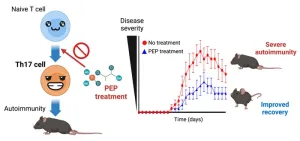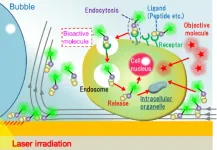(Press-News.org) Study’s findings may lead to more personalized follow-up care for patients.
New research indicates that for patients with breast cancer, the cancer’s stage and receptor status can help clinicians predict whether and when cancer might recur after initial treatment. The findings are published by Wiley online in CANCER, a peer-reviewed journal of the American Cancer Society.
For the study, Heather Neuman, MD, MS, of the University of Wisconsin, and her colleagues analyzed data on 8,007 patients with stage I–III breast cancer who participated in nine clinical trials from 1997–2013 and received standard of care therapy.
Time to first cancer recurrence varied significantly between cancers with different receptors—including estrogen receptor (ER), progesterone receptor (PR), and human epidermal growth factor receptor 2 (HER2). Within each receptor type, cancer stage influenced time to recurrence.
Risk of recurrence was highest and occurred earliest for ER−/PR−/HER2− (triple negative) tumors. Patients with these tumors diagnosed at stage III had a 5-year probability of recurrence of 45.5%. Risk of recurrence was lowest for ER+/PR+/HER2+ (triple positive) tumors. Patients with these tumors diagnosed at stage III had a 5-year probability of recurrence of 15.3%.
Based on their findings, the investigators developed follow-up recommendations by cancer stage and receptor type. For example, patients with the lowest risk should be seen by their oncology team once annually over five years, whereas those with the highest risk should be seen once every three months over five years.
“Our developed follow-up guidelines present an opportunity to personalize how we deliver breast cancer follow-up care,” said Dr. Neuman. “By tailoring follow-up based on risk, we have the potential to have a strong, positive impact on both survivors and their oncology providers by improving the quality and efficiency of care.”
Additional information
NOTE: The information contained in this release is protected by copyright. Please include journal attribution in all coverage. A free abstract of this article will be available via the CANCER Newsroom upon online publication. For more information or to obtain a PDF of any study, please contact: Sara Henning-Stout, newsroom@wiley.com
Full Citation:
“The influence of anatomic stage and receptor status on first recurrence for breast cancer within five years (AFT-01).” Heather B. Neuman, Jessica R. Schumacher, Stephen B. Edge, Kathryn J. Ruddy, Ann H. Partridge, Menggang Yu, David J. Vanness, Bret M. Hanlon, Jennifer G. Le-Rademacher, Dou-Yan Yang, Jeffrey Havlena, Carrie A. Strand, and Caprice C. Greenberg. CANCER; Published Online: March 6, 2023 (DOI: 10.1002/cncr.34656).
URL Upon Publication: http://doi.wiley.com/10.1002/cncr.34656
Author Contact: Sara Benzel, media relations manager at UW Health, at SBenzel@uwhealth.org.
About the Journal
CANCER is a peer-reviewed publication of the American Cancer Society integrating scientific information from worldwide sources for all oncologic specialties. The objective of CANCER is to provide an interdisciplinary forum for the exchange of information among oncologic disciplines concerned with the etiology, course, and treatment of human cancer. CANCER is published on behalf of the American Cancer Society by Wiley and can be accessed online. Follow us on Twitter @JournalCancer.
About Wiley
Wiley is one of the world’s largest publishers and a global leader in scientific research and career-connected education. Founded in 1807, Wiley enables discovery, powers education, and shapes workforces. Through its industry-leading content, digital platforms, and knowledge networks, the company delivers on its timeless mission to unlock human potential. Visit us at Wiley.com. Follow us on Facebook, Twitter, LinkedIn and Instagram.
END
Cancer stage and receptor status indicate a breast cancer survivor’s risk of recurrence
2023-03-06
ELSE PRESS RELEASES FROM THIS DATE:
Bees follow linear landmarks to find their way home, just like the first pilots
2023-03-06
In the earliest days of human flight, before the invention of the first radio beacons and ground-based electronic systems, and modern GPS, pilots commonly navigated by following roads and railways – striking linear landscape elements at ground level that guide towards a destination of interest.
Enter the honeybee. A century of research has shown that honeybees are navigators par excellence. They can navigate by their sense of smell, the sun, the sky’s pattern of polarized light, vertical landmarks that stand out from the panorama, and possibly the Earth’s magnetic field. They are also clever learners, able to recognize associations between disparate ...
Community strategy reduced opioid overdose deaths in Pennsylvania counties
2023-03-06
PITTSBURGH, March 6, 2023 — The monthly opioid overdose death (ODD) rate fell by 30% in Pennsylvania counties that implemented a novel community-focused strategy developed by University of Pittsburgh researchers, according to a new study published today in the Journal of Studies on Alcohol and Drugs.
By analyzing counties that did or didn’t implement the Pennsylvania Opioid Overdose Reduction Technical Assistance Center (ORTAC) strategy over time, the researchers estimate that this cost-effective, community-led approach prevented 1,818 opioid-related deaths over two years.
“I ...
A mixture of trees purifies urban air best
2023-03-06
Conifers are generally better than broadleaved trees at purifying air from pollutants. But deciduous tree may be better at capturing particle-bound pollution. A new study led by the University of Gothenburg shows that the best trees for air purification depend on the type of pollutant involved.
Trees and other greenery in cities provide many benefits that are important for the well-being of residents. Leaves and needles on trees filter air pollutants and reduce exposure to hazardous substances in the air. But which trees purify the air most effectively? Researchers from the University ...
Potential treatment of autoimmune diseases revealed in new study
2023-03-06
Scientists in Japan have revealed a chemical compound that could be used for the treatment of various autoimmune diseases like multiple sclerosis and rheumatoid arthritis. These diseases occur when the body’s immune response goes wiry. The immune system, which normally attacks pathogens and infections, instead attacks healthy cells and tissues. For the millions of people who suffer from autoimmune diseases worldwide, the result can be debilitating—rheumatoid arthritis causes excessive joint pain, while multiple sclerosis can disable one’s brain and spinal cord function.
“The key to the development of autoimmune ...
Physical activity and tailored support fails to deliver lasting benefits for smokers not ready to quit
2023-03-06
Promoting physical activity and other behavioural support can help people wanting to reduce their smoking to quit in the short-term.
However, after nine months, physical activity delivers no noticeable benefits – compared with offering no additional support – in the rates of people stopping smoking, according to the findings of a major national study.
The Trial of physical Activity and Reduction of Smoking (TARS) study, led by the University of Plymouth with funding from the National Institute for Health and Care Research, took place across four cities – Plymouth, Nottingham, Oxford and ...
Death rates from lung cancer will fall overall in the EU and UK in 2023, but rise among women in France, Italy and Spain
2023-03-06
A total of 1,261,990 people will die from cancer in 2023 in the EU (EU-27). A further 172,314 people will die from the disease in the UK, according to new research published in the leading cancer journal Annals of Oncology [1] today (Monday).
Researchers led by Carlo La Vecchia (MD), a professor at the University of Milan (Italy), estimate there will be a 6.5% fall in cancer death rates in men and a 3.7% fall in women between 2018 and 2023.
They predict that death rates from the ten most common cancers will continue to fall in most European countries in 2023, although the numbers of people dying will go up ...
As urban populations soar wastewater treatment struggles to find sustainable solutions
2023-03-06
Globally, activated sludge treats the majority of urban wastewaters; yet it is one of the most complex biological processes used. It is a sophisticated microbial process fraught with operational problems leading to occasional failures in achieving required effluent quality standards. With the increasing problem of partially treated and raw sewage entering rivers and estuaries, the pressure on the process to cope with ever increasing volumes of wastewater has never been so great.
With increasing volumes of dilute wastewater entering treatment plants the high variability in hydraulic and organic ...
Light-induced acceleration of intracellular delivery
2023-03-06
Cell membranes are barriers that maintain cellular homeostasis, and the intracellular delivery of biologically functional molecules, including peptides, proteins, and nucleic acids to manipulate cellular functions. Conventional intracellular uptake processes require high concentrations of biofunctional molecules with low permeability to pass through the cell membrane. This results in low drug activity because the probability of the biofunctional molecules entering target cells and their organelles is low. In addition, many drugs damage healthy cells as well as the cells that are supposed to target due to poor selectivity, making ...
Physician workforce planning must adjust for aging population, changing practice patterns: New analysis
2023-03-06
Why are Canadians having problems accessing physicians despite historic highs in physician numbers? Factoring in changing demographics and physician work trends can help with physician workforce planning, according to a new analysis in CMAJ (Canadian Medical Association Journal) https://www.cmaj.ca/lookup/doi/10.1503/cmaj.221239.
"[T]he increasing [health care] needs of an aging population have been empirically important since around 2005, while the supply of physician service hours has simultaneously declined in a manner that is largely unrelated to the evolving age–sex composition of the physician workforce," writes Dr. Arthur Sweetman, ...
Pregnant people with schizophrenia have threefold risk of interpersonal violence
2023-03-06
Pregnant and postpartum people with schizophrenia have a more than threefold increase in the risk of an emergency department visit for interpersonal violence, compared with those without schizophrenia, according to a new study in CMAJ (Canadian Medical Association Journal) https://www.cmaj.ca/lookup/doi/10.1503/cmaj.220689.
Interpersonal violence can include physical, sexual and psychological abuse by a family member, intimate partner, acquaintance or stranger.
"Though we found a threefold increased risk for individuals with schizophrenia, we also found that ...





